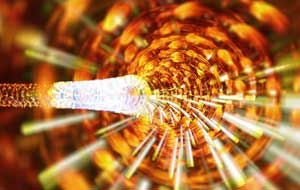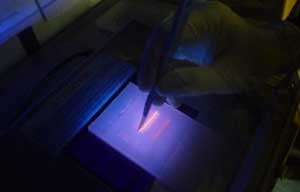Delivered in partnership with the Australia Council for the Arts, the Synapse Residencies place Australian artists into science and research settings to pursue collaborative projects with benefits accruing to both the resident and the host organisation. The Synapse initiative supports creative partnerships between scientists and artists through the residency program, a database of international art/science collaborations, an archived discussion list and the Australian Research Council (ARC) Linkage program, which supports longer-term partnerships between artists and scientists in academic research settings.
Five Australian artists were awarded Synapse residencies for 2010:
 Robin Fox + Bionic Ear Institute (Melbourne, Australia)
Robin Fox + Bionic Ear Institute (Melbourne, Australia)
Whilst cochlear implants have been remarkably successful in restoring speech perception, they present an issue in music appreciation for implant users. Robin Fox, one of Australia’s leading audio-visual, sound and computer music artists, worked with researchers from the Bionic Ear Institute’s Music and Pitch Project Team to create musical compositions tailored specifically for implant users. The collaboration allowed Fox to further his research into audio-visual equivalence by conducting a series of experiments investigating whether visual stimuli accompanying sound can increase the musical experience for the hearing impaired.
 Chris Henschke + Australian Synchrotron (Melbourne, Australia)
Chris Henschke + Australian Synchrotron (Melbourne, Australia)
In 2007, artist Chris Henschke completed a residency at the Australian Synchrotron, supported by Arts Victoria’s Innovation Residency program and ANAT. Following this, he continued to build his understanding of the facility and strengthened his relationships with the resident scientists, a process that has informed this project. ‘Lightbridge’ aimed to create an audio-visual interface to explore the nature of the synchrotron’s ‘tune’ – what scientists call the complex frequency harmonics generated from the synchrotron’s beam status and position data – and to make this real-time data available to other artists and researchers.
http://henschke2010.anat.org.au/
 Erica Seccombe + Department of Applied Mathematics, Australian National University (Canberra, Australia)
Erica Seccombe + Department of Applied Mathematics, Australian National University (Canberra, Australia)
Visual artist, Erica Seccombe worked with experimental and theoretical scientists from the Department of Applied Mathematics on a collaboration that will assist towards understanding the complex interrelationship of mechanical 3D components of physical objects and balancing visual density with information content. A complementary and concurrent focus on the visualisation and animation of complex datasets also contributed to Seccombe’s long-term research project looking at the influence of scientific technology on visual media and contemporary art, as well as producing a wealth of material for use in future artworks.
http://seccombe2010.anat.org.au/
 Meredith Walsh + Pier Luigi Luisi Synthetic Biology Laboratory (Rome, Italy)
Meredith Walsh + Pier Luigi Luisi Synthetic Biology Laboratory (Rome, Italy)
The primary research undertaken at the Pier Luigi Luisi Lab investigates the self-organisation and self-reproduction of chemical and biological systems within ‘origins of life’ and cell model frameworks; in particular, the Lab uses random DNA sequencing to modify protein structure and synthesise new proteins. UK-based artist Meredith Walsh wanted to take this a full step further: rather than relying on random selection, she experimented with modifying proteins using aesthetic criteria to question the ways in which the design and modification of proteins can alter their architecture and expression and to address the ethical implications of designing new biological systems.
Ken and Julia Yonetani + Sunrise 21 +The Murray-Darling Freshwater Research Centre (Mildura, Australia)
Visual artists, Ken and Julia Yonetani used their residency to further their practice of collaborating with scientists to produce outstanding works engaging with the fragility of the environment. Their recent collaboration with the Australian Institute of Marine Science resulted in the work Sweet Barrier Reef, which represented Australia at the 2009 Venice Biennale. The Water Memory project focused on water as life-force and carrier of the ‘memory’ of all living entities -past, present and future. Sunrise 21′s expertise in advanced digital mapping and the Freshwater Research Centre’s work on water quality and ecology enabled a research engagement ranging from the microscopic to the macroscopic ‘big picture’.
http://yonetani2010.anat.org.au/
ANAT’s Program Manager Vicki Sowry comments, ‘…Artists and scientists approach creativity, exploration and research in different ways and from different perspectives; when working together they open up new ways of seeing, experiencing and interpreting the world around us’.
Andrew Donovan, Inter-Arts Director at the Australia Council for the Arts notes, ‘…Each of the Synapse residencies demonstrates an exciting and genuine collaboration between artists and scientists. They create awareness that artists can contribute to the building of new knowledge in disciplines well beyond those we’d normally associate with artistic practice’.
For further information, please contact Vicki Sowry at ANAT, +(61) 8 8231 9037, [email protected], or visit www.synapse.net.au





